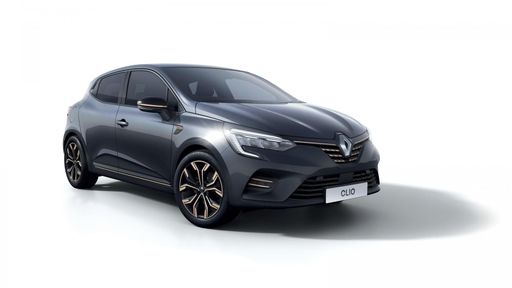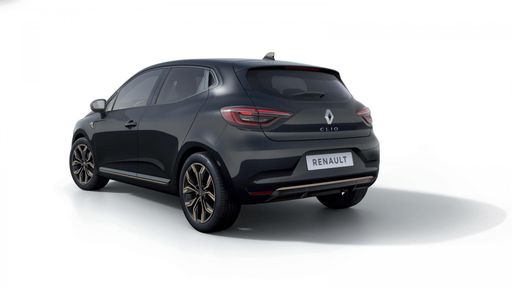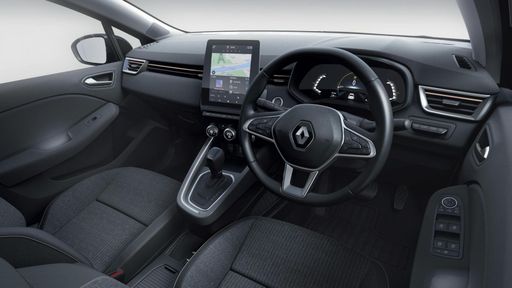Fiat Ducato VS Renault Clio – Specs, Efficiency & Price Comparison
Which model is the better choice – the Fiat Ducato or the Renault Clio? We compare performance (270 HP vs 143 HP), boot capacity ( vs 391 L), efficiency (7.20 L vs 4.30 L), and of course, the price (34200 £ vs 16600 £).
Find out now which car fits your needs better!
The Fiat Ducato (Cargo Van) is powered by a Diesel or Electric engine and comes with a Manuel or Automatic transmission. In comparison, the Renault Clio (Hatchback) features a Full Hybrid, Petrol or LPG engine and a Automatic or Manuel gearbox.
When it comes to boot capacity, the Fiat Ducato offers , while the Renault Clio provides 391 L – depending on what matters most to you. If you’re looking for more power, you’ll need to decide whether the 270 HP of the Fiat Ducato or the 143 HP of the Renault Clio suits your needs better.
There are also differences in efficiency: 7.20 L vs 4.30 L. In terms of price, the Fiat Ducato starts at 34200 £, while the Renault Clio is available from 16600 £.
Compare all the key specs now and find out which model fits your lifestyle best!
Fiat Ducato
The Fiat Ducato is a versatile vehicle that has remained popular among business owners and adventurers alike. With its spacious interior and practical design, it is ideal for transporting goods or converting into a camper van for travel enthusiasts. Its robust performance and reliability have solidified its reputation as a staple in the commercial van market.
detailsRenault Clio
The Renault Clio continues to impress with its sleek design and agile handling, making it a standout choice in the compact car segment. Inside, it offers a surprisingly spacious and comfortable cabin, crafted with high-quality materials that enhance the driving experience. Its fuel efficiency and reliable performance make it an attractive option for both city commuting and longer journeys.
details @ renault-presse.de
@ renault-presse.de
 @ renault-presse.de
@ renault-presse.de
 @ renault-presse.de
@ renault-presse.de

|
|
|
|
|
Costs and Consumption |
|
|---|---|
|
Price
34200 - 57800 £
|
Price
16600 - 23000 £
|
|
Consumption L/100km
7.2 - 9.3 L
|
Consumption L/100km
4.3 - 7 L
|
|
Consumption kWh/100km
-
|
Consumption kWh/100km
-
|
|
Electric Range
430 km
|
Electric Range
-
|
|
Battery Capacity
-
|
Battery Capacity
0.60 kWh
|
|
co2
0 - 244 g/km
|
co2
97 - 122 g/km
|
|
Fuel tank capacity
90 L
|
Fuel tank capacity
32 - 42 L
|
Dimensions and Body |
|
|---|---|
|
Body Type
Cargo Van
|
Body Type
Hatchback
|
|
Seats
3
|
Seats
5
|
|
Doors
4
|
Doors
5
|
|
Curb weight
2075 - 2940 kg
|
Curb weight
1124 - 1331 kg
|
|
Trunk capacity
-
|
Trunk capacity
301 - 391 L
|
|
Length
5413 - 6678 mm
|
Length
4053 mm
|
|
Width
2050 - 2100 mm
|
Width
1798 mm
|
|
Height
2254 - 2774 mm
|
Height
1440 mm
|
|
Payload
560 - 2020 kg
|
Payload
398 - 406 kg
|
Engine and Performance |
|
|---|---|
|
Engine Type
Diesel, Electric
|
Engine Type
Full Hybrid, Petrol, LPG
|
|
Transmission
Manuel, Automatic
|
Transmission
Automatic, Manuel
|
|
Transmission Detail
Schaltgetriebe, Automatikgetriebe
|
Transmission Detail
Automatikgetriebe, Schaltgetriebe
|
|
Drive Type
Front-Wheel Drive
|
Drive Type
Front-Wheel Drive
|
|
Power HP
120 - 270 HP
|
Power HP
67 - 143 HP
|
|
Acceleration 0-100km/h
-
|
Acceleration 0-100km/h
9.3 - 17.1 s
|
|
Max Speed
130 - 165 km/h
|
Max Speed
160 - 174 km/h
|
|
Torque
320 - 450 Nm
|
Torque
95 - 205 Nm
|
|
Number of Cylinders
4
|
Number of Cylinders
3 - 4
|
|
Power kW
88 - 200 kW
|
Power kW
49 - 105 kW
|
|
Engine capacity
2184 cm3
|
Engine capacity
999 - 1598 cm3
|
General |
|
|---|---|
|
Model Year
2023 - 2024
|
Model Year
2023 - 2024
|
|
CO2 Efficiency Class
E, G, A
|
CO2 Efficiency Class
C, D
|
|
Brand
Fiat
|
Brand
Renault
|
Fiat Ducato
Introducing the Iconic Fiat Ducato
The Fiat Ducato stands as a testament to the evolution of commercial vehicles, making its mark with unmatched versatility and innovative technology. As a staple in Fiat’s lineup, it caters to a diverse range of business needs. In this piece, we delve into the technical intricacies and forward-thinking innovations that make the Fiat Ducato a standout in its class.
Power and Performance
At the heart of the Fiat Ducato lies an impressive array of powertrains. The lineup includes robust diesel engines, boasting power outputs ranging from 120 to 180 PS, and the forward-thinking e-Ducato with a remarkable 270 PS. The Multijet3 diesel engines ensure an efficient and dynamic driving experience, offering CO2 emissions from as low as 148 g/km. The electrified options further speak to Fiat’s commitment to a sustainable future, with the e-Ducato offering an impressive range of 430 km on a single charge.
Innovative Engineering
Fiat has seamlessly integrated innovation into the Ducato, starting with the transmission options. Customers have the choice between manual and automatic gearboxes, allowing for a tailored drive. Safety and ease of operation remain a priority with state-of-the-art driver assistance systems, enhancing both safety and driver comfort, regardless of the configuration.
Versatility and Utility
The Fiat Ducato is designed to meet a wide array of professional needs. It is available in varying configurations, each optimised for different utility purposes. With a payload capacity ranging from 560 to 2020 kg, the Ducato does not compromise on practicality. Whether it's transporting goods across town or serving as a mobile workshop, this vehicle is adaptable to your business’s specific needs.
Dimensions and Capacities
The Fiat Ducato caters to every requirement with multiple sizing options. Its lengths span from 5413 to 6678 mm, making it suitable for diverse logistical needs. Despite its ample size, the Ducato's aerodynamic design ensures enhanced fuel economy, with consumption figures between 7.2 to 9.3 L/100km depending on the model and configuration.
Environmental Considerations
Fiat’s commitment to reducing the ecological footprint is evident in the Ducato’s inclusion of environmentally conscious features. The CO2 efficiency class ranges from E to G, and for those seeking zero emissions, the e-Ducato provides an electric alternative without compromising on performance or load capacity.
The Interior Experience
The Fiat Ducato ensures that the driving experience is a comfortable one. The cabin is ergonomically designed, offering high visibility and an intuitive control layout. Safety features such as lane departure warning and emergency braking systems are designed to meet modern safety standards, providing peace of mind on every journey.
Conclusion
In the realm of commercial vehicles, the Fiat Ducato continues to lead with its blend of power, practicality, and progressive technology. Whether you're opting for diesel or the sustainable electric variant, the Ducato promises reliability and efficiency, making it a preferred choice for businesses across Europe.
Renault Clio
Introduction to the Renault Clio
The Renault Clio, a popular choice among compact cars, has continually advanced its design and technology to maintain a strong position in the automotive market. With enhancements in engineering, efficiency, and aesthetic appeal, the Clio remains a top contender in the hatchback category.
Advanced Hybrid Technology
The Renault Clio's hybrid technology is one of its standout features. The E-Tech Hybrid system optimises both performance and efficiency, offering a seamless transition between electric and fuel-powered driving. This setup results in an impressive fuel consumption rate of 4.3 L/100km, making it an attractive option for eco-conscious drivers.
Efficient Engine Options
Renault offers a variety of engine choices for the Clio, accommodating different driving styles and preferences. From the economical SCe 65 manual variant to the powerful TCe 100 LPG gas version, each option is engineered to balance performance with fuel efficiency. With outputs ranging from 67 to 143 PS, drivers can enjoy a tailored driving experience.
Design and Comfort
The Renault Clio stands out with its sleek and modern design, characterized by its hatchback body style. The interior boasts an ergonomic layout with seating for five, ensuring passenger comfort and convenience. With a boot capacity of 301 to 391 litres, the Clio also offers practical storage solutions for everyday use.
Safety and Innovation
Safety is a key priority for Renault, and the Clio reflects this commitment with its suite of innovative safety features. Advanced driver-assistance systems are integrated throughout, enhancing both safety and usability. The Clio encompasses features like lane departure warning, automatic emergency braking, and adaptive cruise control.
Cost Efficiency and Environmental Impact
The Renault Clio not only offers affordability with pricing ranging from €18,450 to €26,800, but also promises low running costs. With CO2 emissions between 97 and 130 g/km, the Clio fits well within the C and D efficiency classes. This makes it a cost-effective and environmentally friendly choice for modern drivers.
Conclusion
Renault Clio remains a dynamic, dependable and economical option in the compact car segment. With its innovative technologies, diverse engine options, and commitment to safety and design, the Clio continues to impress and adapt to the evolving demands of the automotive world.
The prices and data displayed are estimates based on German list prices and may vary by country. This information is not legally binding.
